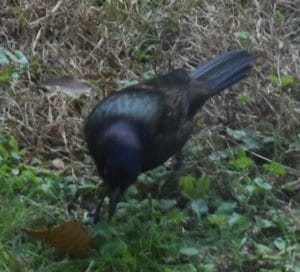Hello Fellow Readers, While recording episode six of my new podcast series from the screened porch, an arresting sound came from thousands of swarming blackbirds that landed in our front yard. Squawking and feeding for a few minutes, then they took off in a synchronized wave – exploding like a helicopter- softer, of course, but considering the size of the birds, their sounds were significant and glorious. It goes to show there’s volume in numbers.
Swarming Blackbirds are likely Common Grackles
I reached out to my birder buddy Dennis of Blairstown, NJ, who said, “They’re most likely Common Grackles. They move through our area this time of the year, sometimes by the many thousands. They like to raid our cornfields too.”
Feeding off the fall remnants isn’t so bad. But Common Grackles are known for snagging newly planted corn and even sprouting seedlings causing multimillion dollars in damage to crops.
Characteristics of Common Grackles
Common Grackles are about the size of Mourning Doves with long tails, yellow eyes, and black beaks. In the sky, they look solid black, but with closer inspection, they have an iridescent purple-bluish to a greenish sheen. When they roost in the trees, they look like ornaments filling in the vacancy where our leaves once were.
Quiscalus quiscula are social birds nesting in colonies of up to two hundred nests. They often migrate with other species of blackbirds though our visitors (who’ve come dozens of times) seem to be all grackles.
Swarming Grackles recall Hitchcock’s thriller The Birds.
There’s a fascinating article on the University of Delaware’s website titled Blackbirds Fly. It talks about a mixed super flock of millions of blackbirds – common grackles, red-winged blackbirds, brown-headed cowbirds, and starlings- that choose Churchman’s Marsh, DE, as their winter home. Depending on the food source over winter, they’ll travel to Chester County and Lancaster, PA, to feed and then return to the marsh to roost.
The massive waves of birds recall Alfred Hitchcock’s classic thriller The Birds, about millions of birds becoming violent killers of man and beast. Common crackles are not considered vicious, although as social as they are, they defend their nests and attack other birds. I also read they’re inventive foragers, snagging worms from robins, stealing eggs from nests, and scoffing down smaller adult birds. They eat almost anything. They feed primarily on insects and other invertebrates during breeding, like worms and frogs. They also eat mice and small bats. Come migration and wintertime, they mainly eat seeds and grains from farm fields. They even eat trash.
Scientists attribute the formation of super flocks to protect against predators. Traveling in massive groups creates “predator confusion,” much like fish swimming in schools. Indeed, there can be safety in numbers as long as everyone gets along.
Garden Dilemmas? AskMaryStone.@gmail.com (and your favorite Podcast App.)
This story is featured in Episode 7 of the Garden Dilemmas Podcast:
Other helpful links: Visit Cornell’s nifty site All About Birds to learn more about Common Grackles. You may also enjoy a long-ago column inspired by my birder buddy Dennis about feeding birds titled Winter is for the Birds.





Dear Mary,
We have hundreds of common grackles that have been roosting/ nesting for the past three springs and summers.
Can you recommend a method that will repel them from our yard. I recognize they are a protected species but they fly through my yard all day long and leave fecal material all over. We are all immunocompromised and my husband had a heart transplant. Can you make any recommendations?
Hello Candy, I have no idea how to deter them. I wonder if your local Animal Control authorities could help you find a solution? Thank you for reading my column. Wishing you good health, Mary